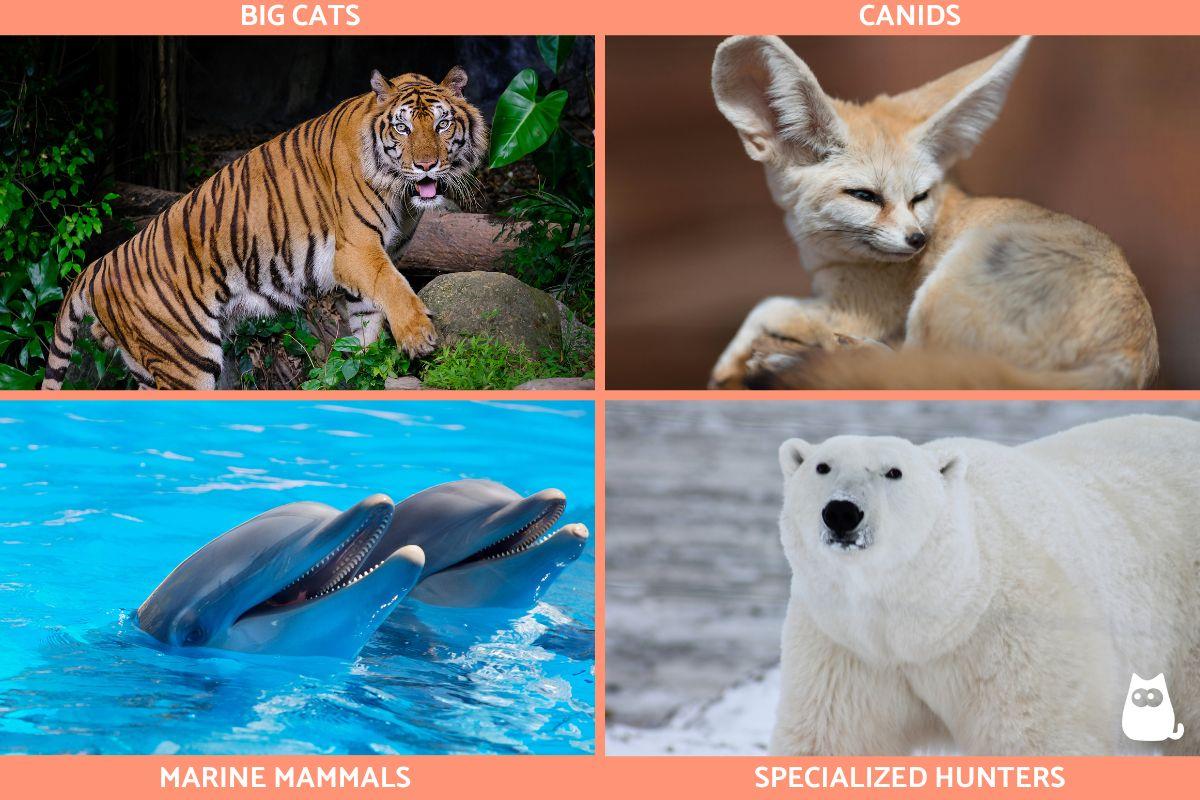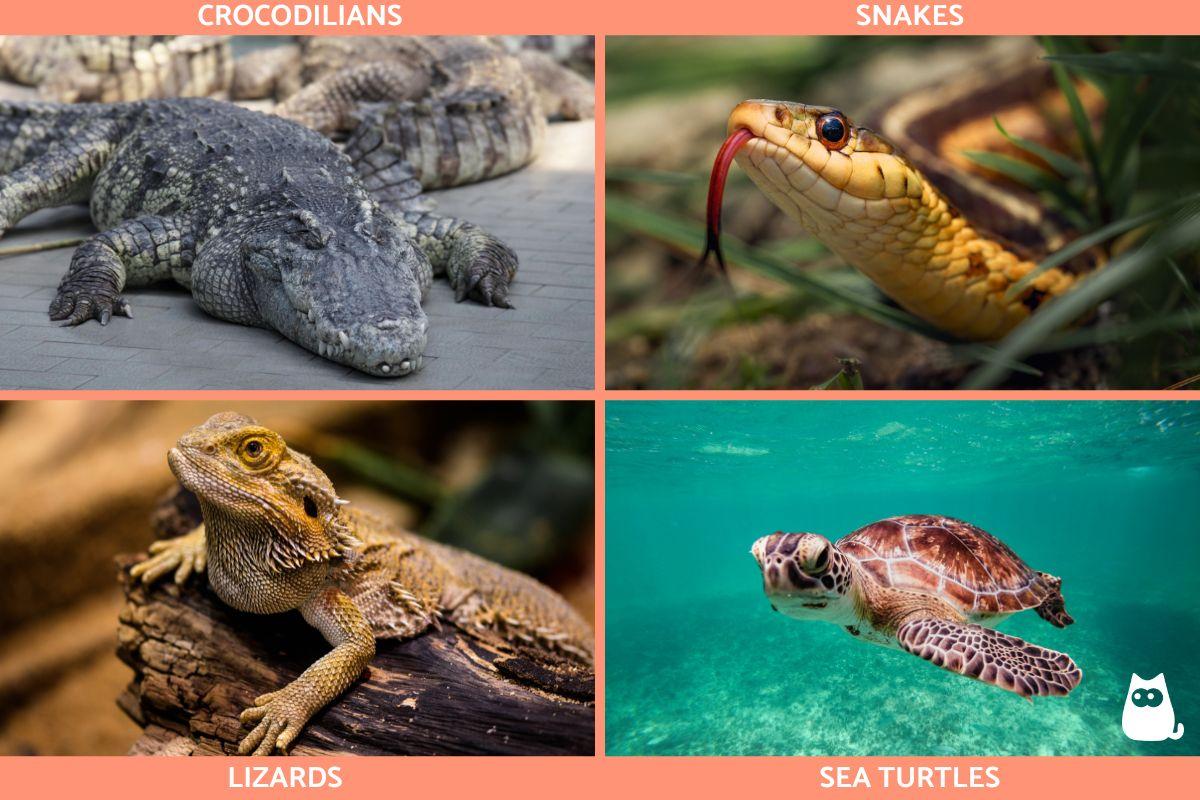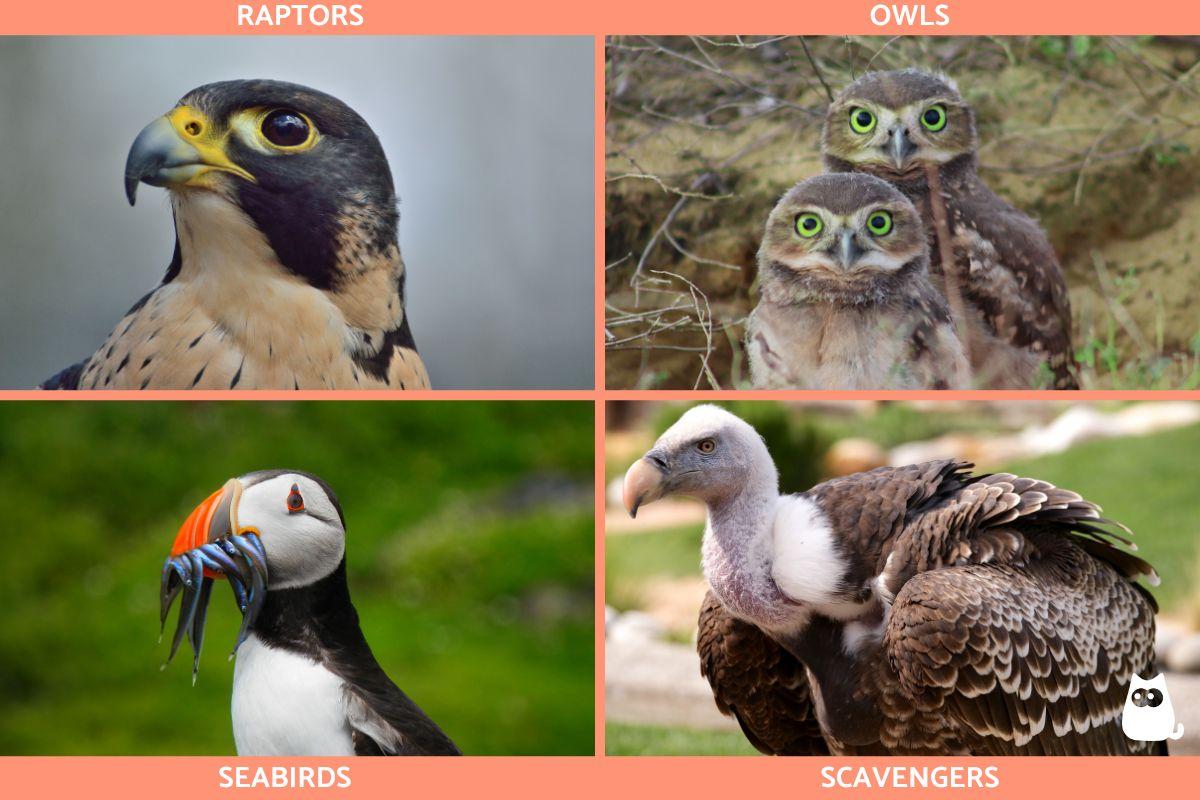What Are Carnivorous Animals? - Examples and Facts

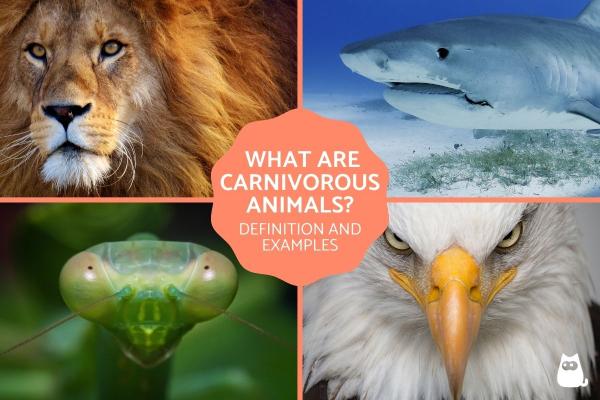
What makes lions, sharks, and eagles such effective hunters? The answer lies in their carnivorous nature. Carnivorous animals get their energy and nutrients primarily by eating meat. From tigers to spiders, meat-eating animals exist across all major animal groups and play crucial roles in maintaining ecological balance.
In this AnimlaWised article, we'll explore what carnivores animals are, their types, distinctive characteristics, and examples from around the world.
What are carnivorous animals?
Carnivorous animals are those that primarily feed on the flesh of other animals. The term "carnivore" comes from Latin, and it literally means "devourer of meat."
Carnivores get their nutrition by eating other animals, either by hunting live prey or consuming already dead animals. They may eat muscle tissue, internal organs, bones, and other body parts depending on the species.
In the food chain, carnivores typically occupy higher levels as consumers. They play a vital role in controlling populations of other animals, which helps maintain balanced ecosystems. Without predators, certain species would overpopulate, potentially causing environmental damage.
What do carnivores eat?
There's a lot of variety in what carnivorous animals eat, as each species tends to prefer different kinds of prey:
- Large predators: like lions and wolves typically target medium to large herbivores, providing substantial nutrition for their energy needs.
- Piscivores: such as ospreys, otters, and herons have developed specialized techniques for catching underwater prey. Their bodies often show adaptations like webbed feet, waterproof feathers, or specialized bills.
- Insectivores: consume various bugs and arthropods, sometimes in large quantities. Some bats (Chiroptera) can catch hundreds of insects per hour, while anteaters and pangolins have evolved specialized tongues to extract ants and termites from their nests.
- Avivores: like the peregrine falcon (Falco peregrinus) have evolved incredible speed, with diving speeds reaching over 200 mph when pursuing avian prey.
- Vermivores: feed specifically on worms. Many bird species like American robins (Turdus migratorius) and European blackbirds (Turdus merula) extract these protein-rich invertebrates from soil, using specialized bills to probe the ground.
- Molluscivores: specialize in eating mollusks such as snails, clams, and mussels. These predators often have adaptations for breaking hard shells, like the specialized bills of oystercatchers or the powerful jaws of certain fish species.
- Scavengers: like vultures and hyenas eat animal remains left by other predators, serving an important ecological role in removing carcasses and recycling nutrients.
While some meat-eaters are absolute purists, others are more opportunistic. During lean times, when prey is hard to find, a significant number of carnivores will add plants to their meals.
Types of carnivorous animals
Carnivores can be classified in several ways based on their feeding habits and specializations:
Hunting method:
How animals obtain their meat helps us understand their ecological roles:
- Active predators: these animals hunt and kill their prey. Lions pursuing gazelles or eagles swooping down on rabbits exemplify active predation. Their bodies and behaviors have evolved specifically for hunting.
- Scavengers: these carnivores feed on already dead animals. Vultures are classic scavengers, but many hyenas also obtain a significant portion of their food through scavenging. This approach is an efficient survival strategy that complements the role of predators.
Diet:
Carnivores can also be classified based on their dependence on meat:
- Strict carnivores (hypercarnivores): these animals eat more than 70% meat and have digestive systems that cannot process plant material effectively. Tigers, polar bears, and domestic cats fall into this category.
- Flexible carnivores (mesocarnivores): while primarily meat-eaters, these animals can digest some plant material. Coyotes exemplify this category, hunting small animals but also consuming fruits and berries when available.
- Occasional carnivores (hypocarnivores): these animals eat less than 30% meat and are generally considered omnivores, but may rely more heavily on meat during certain periods. Raccoons are typical hypocarnivores, adapting their diet to available food sources.
Did you know that your purring housemate has a digestive system specially adapted for meat consumption? Explore the fascinating evolutionary story behind your cat's dietary needs in our other article.
Key characteristics of carnivorous animals
What makes carnivores different from plant-eaters and omnivores are the specific traits they've developed. Everything about them, from their senses to their digestive system, works together to help them effectively locate, catch, consume, and process meat.
Digestive system adaptations:
Carnivores have digestive systems specifically built for handling meat. Since meat is easier to break down than tough plant fiber, they typically have significantly shorter digestive tracts than herbivores. A lion can digest its meal in about 24 hours, but a plant-eating elephant might take up to 50 hours.
Their efficient digestion is also boosted by incredibly acidic stomachs, often with pH levels dipping to 1. This strong acid quickly breaks down meat protein and kills off potentially harmful bacteria found in raw flesh.
Specialized enzymes work alongside this system, helping them pull every last bit of nutrition from their prey without needing long intestines for absorption. Crucially, most strict carnivores simply lack the necessary gut bacteria and enzymes to process plant matter like cellulose. This is exactly why animals like house cats are "obligate" carnivores, their bodies just aren't equipped to get the nutrients they need from plants.
Physical hunting adaptations:
Carnivores have evolved specific physical adaptations for hunting. Their sharp, specialized teeth are key, from the stabbing canines of wolves to the shearing carnassials of big cats. Backed by powerful jaw muscles, these teeth deliver impressive bite force that can bite through a turtle shell or crush a skull.
Claws are another vital tool for capturing prey, varying from the retractable claws of felines to the powerful talons of eagles.
Carnivores' senses are also tuned for the chase. Forward-facing eyes provide the depth perception essential for judging strike distance, while keen senses of smell help trackers like wolves follow scents over long distances.
Even their body shapes are specialized for different hunting styles. Wolves, built for pursuit, have lean, enduring physiques, while ambush hunters like tigers are packed with muscle for explosive acceleration. Some carnivores even use unique strategies like the venom snakes employ to quickly subdue prey and reduce danger to themselves.
Behavioral hunting:
Carnivores also have developed clever hunting behaviors honed over millennia. Their methods for obtaining prey are quite diverse, ranging from the synchronized efforts of wolf packs to the solitary, stealthy approach of stalking big cats.
Many are also expert trackers and are able of following subtle cues like scent trails over vast distances. Securing reliable hunting grounds is crucial, therefore territorial behavior helps ensure they have consistent access to prey. In that sense, food caching is another crucial strategy because, by burying excess food or storing carcasses in trees, they create essential food security when hunting proves difficult.
Examples of carnivorous animals by group
Carnivorous mammals:
Mammals include some of the most recognized predators on Earth:
- Big cats: lions, tigers, jaguars, and leopards. They hunt using a mix of strength, stealth, and agility. They have claws that pull back and powerful jaws, useful for catching large prey.
- Canids: a group including wolves, coyotes, and foxes. They are known for their stamina and often hunt together in groups. A wolf pack, for example, can kill prey much larger than any single wolf could on its own.
- Marine mammals: like orcas, dolphins, and seals are intelligent hunters. The orca, the largest kind of dolphin, eats everything from fish to seals and even other whales.
- Highly specialized hunters: such as the polar bear. It's the largest carnivore on land and built specifically for hunting in the Arctic. Its white fur helps it blend in with the snow, and large paws help it move safely on ice.
Did you know that mammals returned to the water after their ancestors had already evolved to live on land? Explore more about the evolutionary journey of aquatic mammals in our other article.
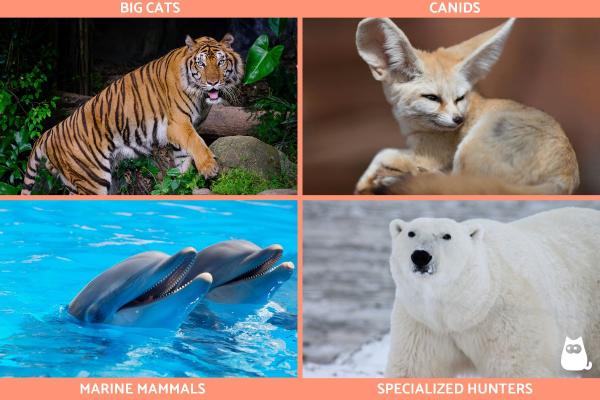
Carnivorous reptiles:
Reptiles include some powerful carnivores too:
- Crocodilians: this group covers crocodiles, alligators, caimans, and gharials. They are ambush hunters with incredibly strong bites and have looked much the same for millions of years.
- Snakes: are meat-eaters, whether they constrict prey (like boas and pythons) or use venom (like cobras and vipers). They have unique jaws that can stretch wide, letting them swallow animals much larger than their own head.
- Lizards: the Komodo dragon is the largest. It hunts using a mix of venom, bacteria, and brute force. These big reptiles can even take down prey as large as water buffalo.
- Sea Turtles: many eat jellyfish, crustaceans, and small fish. The leatherback turtle specializes in eating jellyfish. However, it's worth noting that adult green turtles are an exception; they primarily eat seagrass.
Want to learn more about some of Earth's most ancient and effective hunters? Check out our other article on cold-blooded predators.
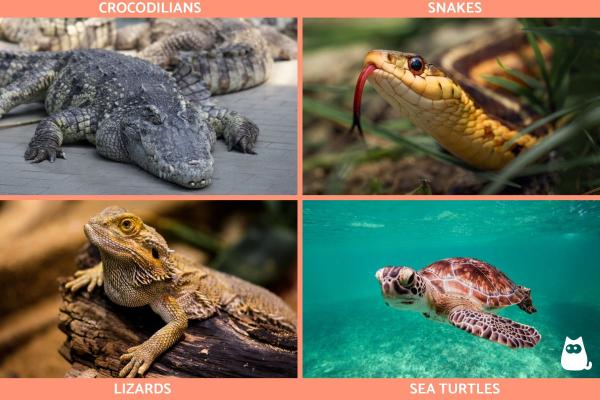
Carnivorous fish:
Aquatic environments contain numerous predatory fish species:
- Sharks: these cartilaginous fish include hunters like the great white shark (Carcharodon carcharias), bull shark (Carcharhinus leucas), and tiger shark (Galeocerdo cuvier). Note that the whale shark (Rhincodon typus) is a filter feeder, not a true carnivore.
- Predatory bony fish: many bony fish are carnivorous, including barracudas, piranhas, and predatory species like bass and pike.
- Deep-sea predators: the deep ocean hosts specialized hunters like anglerfish with bioluminescent lures and gulper eels with expandable jaws.
- Venomous fish: Stonefish (Synanceia) and lionfish (Pterois) combine predatory behavior with venom for both hunting and defense.
Fascinated by deep-sea predators like anglerfish? Dive into the mysterious world of glowing marine creatures and discover how they use light to hunt in the darkest depths.
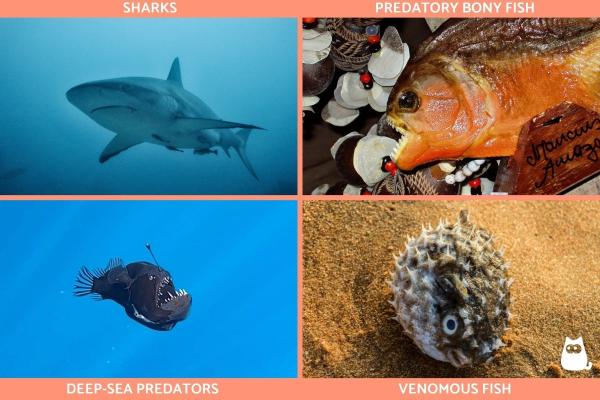
Carnivorous birds:
Many bird species are carnivorous, with specialized adaptations for different hunting styles:
- Raptors: eagles, hawks, and falcons are diurnal hunters with excellent vision and powerful talons. The peregrine falcon (Falco peregrinus) is the fastest animal on Earth, reaching over 200 mph during hunting dives.
- Owls: these nocturnal predators like the great horned owl (Bubo virginianus) and barn owl (Tyto alba) have adaptations for silent flight and excellent night vision.
- Seabirds: many seabirds are piscivores (fish-eaters), including pelicans, ospreys (Pandion haliaetus), and herons.
- Scavengers: vultures and condors specialize in consuming carrion, with adaptations like resistance to pathogens and strong stomach acid.
Interested in nature's aerial hunters? Discover the adaptations of falcons, eagles, owls and other feathered predators in our article on birds that rule the skies.
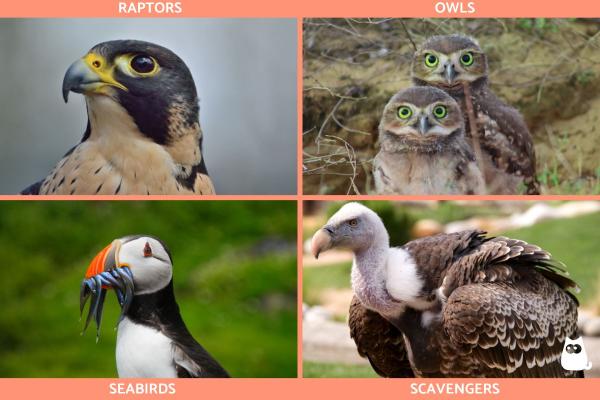
Carnivorous invertebrates:
The invertebrate world contains countless predatory species:
- Arachnids: spiders like the wolf spider (Lycosidae) and scorpions employ various hunting methods, from web-building to active pursuit.
- Cephalopods: octopuses, squids and cuttlefish demonstrate problem-solving abilities in their hunting strategies, using their tentacles and powerful beaks to capture and consume prey.
- Predatory insects: praying mantises, dragonflies, and many beetles (order Coleoptera) have evolved specialized appendages and hunting strategies to capture other insects.
- Marine predators: many crustaceans like crabs and lobsters hunt smaller sea creatures using powerful claws to catch and crush prey.
If you enjoyed learning about carnivores, explore the flexible feeding habits of bears, raccoons, and other adaptive eaters that enjoy the best of both plant and animal foods.
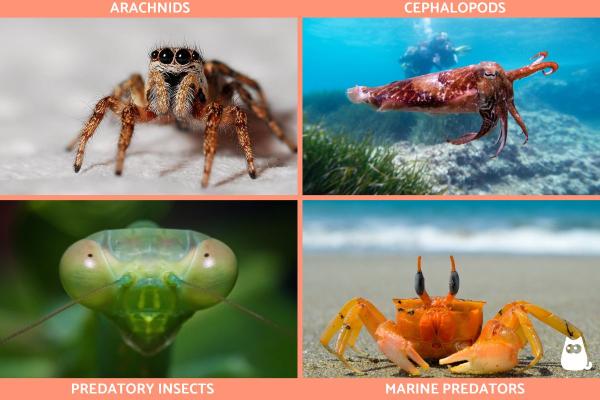
If you want to read similar articles to What Are Carnivorous Animals? - Examples and Facts, we recommend you visit our Facts about the animal kingdom category.
- Animal Diversity Web. (2023). Class Mammalia (mammals). University of Michigan Museum of Zoology. https://animaldiversity.org/accounts/Mammalia/
- Biewener, A. A. (2023). Comparative physiology of terrestrial and aquatic carnivores. Journal of Comparative Physiology B, 193(1), 13-28. https://doi.org/10.1007/s00360-022-01444-7
- Cornell Lab of Ornithology. (2023). Birds of prey. All About Birds. https://www.allaboutbirds.org/guide/browse/taxonomy/Accipitriformes
- International Union for Conservation of Nature (IUCN). (2023). The IUCN Red List of Threatened Species. https://www.iucnredlist.org






